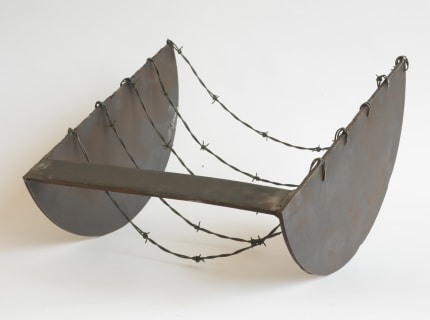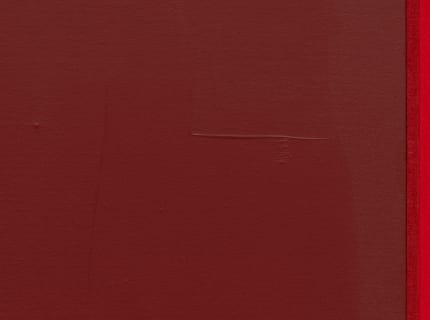In the matter of racial justice, the United States has built up terrible karma over the centuries. And in the past four divisive years, the festering badness, in the form of white nationalism, has been there for all the world to see. The Nigerian-born curator Okwui Enwezor saw it, and the impassioned exhibition “Grief and Grievance: Art and Mourning in America” at the New Museum was his direct and personal response, one that he conceived as a moral broadside and intended to deliver just ahead of the 2020 presidential election.
Fate intervened. Enwezor succumbed to cancer in 2019, at 55, a loss lamented throughout the international art world which he had done much, through his reverberant exhibitions and books, to shape. At that point, four of his longtime colleagues — Massimiliano Gioni, the artistic director of the New Museum; the artist Glenn Ligon; Mark Nash, an art history professor at the University of California, Santa Cruz; and Naomi Beckwith, a senior curator at the Museum of Contemporary Art, Chicago, and soon to be deputy director and chief curator at the Guggenheim Museum — banded together to realize his show. Working from his notes and conversations with him, they gathered the art he had specified, made some additions of their own, and published a catalog.
When I looked through the book in advance of the opening, I had reservations about the project. Most of the 37 Black artists included are familiar and widely exhibited, as are some of the individual works. I wondered if the show, even with the gravity of its theme, wouldn’t end up feeling, basically, like not much more than a reaffirmation of a contemporary art canon, a cavalcade of stars.
The title lays out the show’s intertwined themes: Black grief in response to white racist aggression, and white grievance fueled by a feared loss of dominance and control. A sense of their volatile chemistry is distilled on the New Museum’s facade in a Glenn Ligon text piece that spells out, in large white neon letters, the phrase “blues blood bruise,” words extracted from an interview with a Black New York City teenager, Daniel Hamm, who in 1964 was arrested and brutally beaten by the police.
The theme of racial tension is picked up immediately inside the museum. For a conceptual work titled “Presumption of guilt,” the artist Cameron Rowland has rigged the entrance door with an alert bell, of a kind used in commercial shops to warn owners of the presence of potentially larcenous customers.
There are strong examples of such art on the museum’s third floor. Howardena Pindell’s “Autobiography: Water (Ancestors/Middle Passage/Family Ghosts)” is one: a collage painting with the figure of the artist herself floating, in spectral outline, on an ocean littered with what looks like mortal wreckage — body parts, staring eyes. Another is Melvin Edwards’s great series of wall sculptures, “Lynch Fragments” — there are 10 examples in the show, each a fierce knot of welded-together spikes, chains and screws. And Charles Gaines’s multimedia “Manifestos 3” is a third. In it, the exhortative words of James Baldwin and Martin Luther King, Jr. have been converted into a musical score, recordings of which sound through the gallery.
Indeed, this show is as much an aural as a visual experience. Sound, in one form or another, is everywhere. Some of it is actually silent, as in the case of Jennie C. Jones’s exquisite line drawings collectively titled “Score for Sustained Blackness, Set 3.” Some is happenstantial: microphones embedded in Kevin Beasley’s suspended sculpture “Strange Fruit (Pair 1)” pick up and amplify ambient gallery noise.
The mural-size Bradford picture, it turns out, traces the contours of a government surveillance map of Black neighborhoods in Los Angeles. Issued in the wake of the 1965 Watts rebellion, it was an example of cartography used as a tool for civic control. The four Mehretu paintings on view also carry political content. Half-hidden under abstract patterns in one is a drawing of an image of the 2017 white supremacist rally in Charlottesville, Va.
But it’s another, less conspicuous fourth floor piece that most powerfully encapsulates the karmic interlock — a plague of white aggrievement meeting an emergency of Black grief — that gives the show its theme.
The work is an assemblage painting by Jack Whitten (1939-2018) titled “Birmingham” and dated to 1964. Whitten was born in Alabama, was active in the civil rights movement there, and in 1959, fled the South, never to return. Which doesn’t mean he didn’t look back. In this small piece, done in the aftermath of the 1963 Birmingham church bombing, he did.
The main image is a clipped news photograph of an African-American man at a protest being attacked — it looks like he’s being torn apart — by a white policeman with a dog. (It was after being beaten at such a protest that Whitten took a one-way bus North.) In the piece, the photo is encased, as if it were precious or radioactive, in a nest of molded aluminum foil. And the nest appears to have been half blown open, as if ripped by a detonation that been paused mid-blast.
Can the destruction in progress be stopped, or must it go forward? That’s the question that Enwezor, in his final, urgent show, insists we ask.
...
Read full article at nytimes.com.



